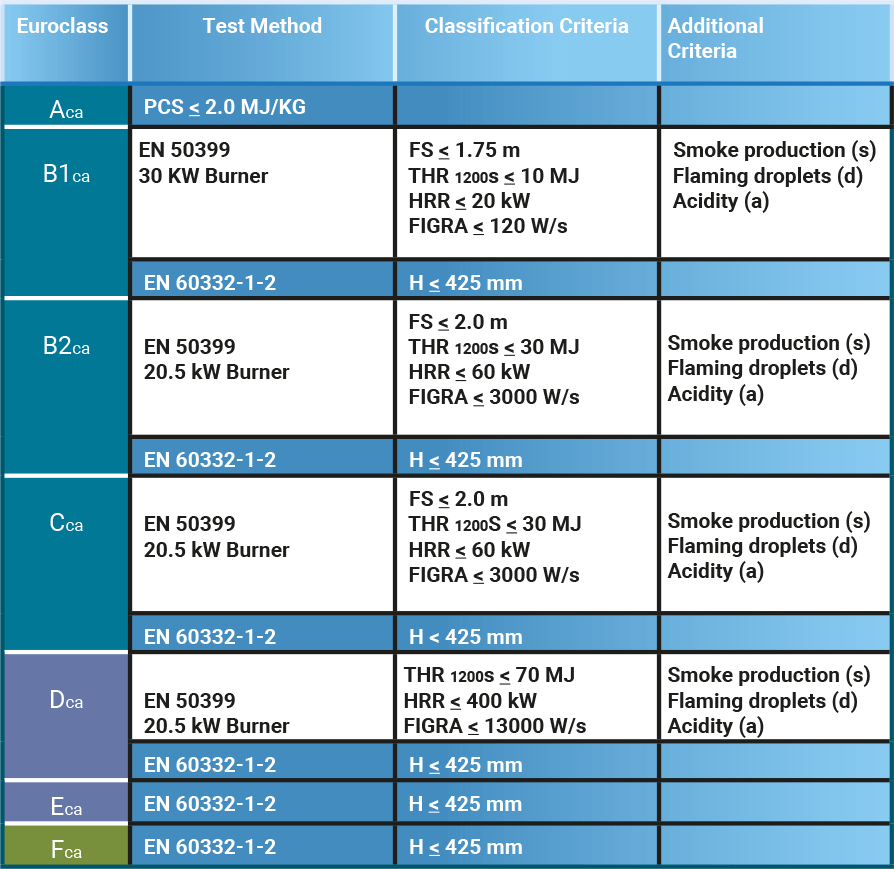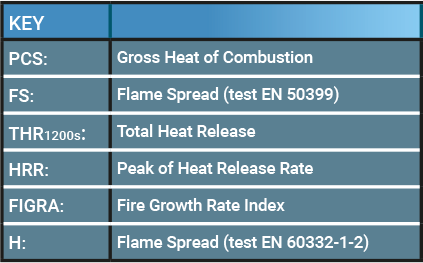Construction Product Regulation (CPR) & Declaration of Performance (DoP)
On July 1st 2017 a new and mandatory ruling with respect to making a cable’s fire related properties publically available came into force, but rather than diving straight into the specifics it may be more useful to start with something of an overview of how and why it came to be.
In the late 1980’s the Construction Products Directive (CPD) introduced a common framework with the intention that it would provide EU-wide standardisation of the regulations used in relation to products used in the building industry. From that point in time member states have had to adopt these standards, so long as an appropriate one exists, rather than their own which is why today you’re just as likely to see ‘EN’ prefixing a standard as ‘BS’. The CPD was superseded in 2011 by the Construction Products Regulation (CPR) and it introduced the EU’s seven Basic Requirements for Construction Work (BRCW), with requirement number 2 being entitled ‘Safety in case of fire’ which, as the title may suggest, is from where this new legislation emanates.
What is the Declaration of Performance?
A DoP is the manufacturer’s written and legally binding assurance that if their product is exposed to fire it will react in a known way because it’s been tested in line with EN 50575:2014. This dictates exactly the tests to be carried out and how the results affect the product’s categorisation. Briefly, the tests are used to determine a product’s potential to contribute to the spread of a fire through:
• Heat given off while burning
• How vigorously it burns
• The likelihood of it setting secondary fires through the production of burning droplets of molten material.
• Transparency of smoke emitted during the burning process
• Acidity of any smoke emitted.
Not all categories are subject to all tests; the higher the Euroclass, the more intensive the testing will be.
The aim of this categorisation is to give manufacturers, distributors, specifiers and installers a means to compare products using uniform criterion. As a result the whole industry is able to make an informed decision when choosing cable for a project or application. This is something that until now has been difficult to assess. Cable manufacturers state the standards their products are compliant with, but unless you’re an expert on the finer details of each and every applicable standard (and let’s be honest most of us aren’t) then choosing the right cable involves a time-consuming comparison exercise of technical information provided in different formats by numerous cable manufacturers. CPR compliancy will make this procedure far less onerous and much more accurate.
Euroclass Categories Explained
Now might be an appropriate point at which to look at those Euroclass categories and what they actually mean.
A CPR compliant cable must belong to 1 of 7 Euroclass categories. Each category relates precisely to the way it performed under the appropriate testing, but to simplify things for now let’s dispense with all the detail and just look at the categories and their headline descriptors:
- Fca – Undetermined reaction
- Eca – Basic reaction
- Dca – Improved reaction
- Cca – Reduced reaction
- B2ca – Low reaction
- B1ca – Very low reaction
- Aca – No reaction
The poorest performing Euroclass is Fca which is CPR compliant simply by the virtue it’s been tested and categorised by the manufacturer. Other than that very little detail is available. If you need to know for certain how a product will perform if it burns, (and I’d suggest in most instances you do) then opting for a cable in this category is something of a pointless exercise.
Euroclass Aca is the best performing category. It’s unlikely that many products will achieve, or need to achieve this standard. There’ll undoubtedly be some applications where Aca category products are required, but it’s fair to say they’ll probably be the exception rather than the rule.
Between these two extremes are categories Eca to B1ca with each posing potentially fewer issues during the burning process than the preceding one. Terms such as ‘Basic Reaction’ or ‘Low Reaction’ are fairly loose and open to interpretation. This is where the additional detail in table 1 comes into play.
Table 1

Additional Classification Criteria
Table 1 lists the standards used in testing a product, for each category. With the exception of products in the Aca class (which are subjected to a test regime from a different standard), all the others utilise EN 60332-1-2 in order to verify their flame propagation properties. Additionally products in categories Dca to B1ca incorporate tests from EN 50399 in order to assess their potential for heat release and fire growth / propagation.
If we look at classes Fca & Eca, there appears to be very little, if anything between them. Both are subject to just the one test, EN 60332-1-2, so what’s the difference? Well, as always the devil’s in the detail and in this case EN 60332-1-2 is used to measure a product’s potential for vertical flame spread. Fca category products have a vertical flame spread > 425mm whereas an Eca product must achieve a flame spread ≤ 425mm. Clearly there’s a lot of scope for something to be > 425mm; for example 500mm; 1,000mm; 10,000mm, infinity – you get the picture. In comparison if a cable’s vertical flame spread is ≤ 425mm the one thing you know for certain is that 425mm is the worst case scenario. With the exception of Fca products, all others, Eca to B1ca inclusive, must have achieved a flame spread ≤ 425mm when subjected to this test. There is another difference between Fca & Eca ranked products, but I’ll explain more about that later, so for now let’s look at some of the other Euroclass categories.
Cables belonging to Dca – B1ca categories are not only tested in line with EN 60332-1-2, but EN 50399 also comes into play to measure; smoke emission & transparency, gas acidity, fire growth rate and heat release rate. EN 50399 employs a hotter flame than EN 60332-1-2 and the results are produced from cables bundled together, unlike EN 60332-1-2 where a single product is used. As you can probably imagine there’s a lot of data involved now that we’ve got to this point so, for the sake of all our sanities, you’ll forgive me if I rely on the table below to fill in the detail.
Table 2


If the requirements in column 3 (Classification Criteria) are met during the test process the product is categorised accordingly.
Additional Criteria Explained
Products within Dca to B1ca classes however, must also contain additional information on their DoP. As referenced in the end column of table 2, there are 3 effects of the test process which are reported on. These offer extra data for the person deciding which product is most appropriate for their application.
Smoke Emissions
The first relates to smoke emissions and the results are classified as follows:
- S1 TSP1200 ≤ 50m² & Peak SPR ≤ 0.25m²/s (EN 50399)
- S1a transmittance > 80% (EN 61034-2)
- S1b transmittance > 60% and <80% (EN 61034-2)
- S2 TSP1200 ≤ 400m² & Peak SPR ≤ 1.5m²/s (EN 50399)
- S3 not S1 (a or b) or S2
Potential to start secondary fires
The second records how the product performed during the test process with respect to its potential to start secondary fires by producing flaming droplets of molten material. The results are categorised as follows:
- d0 no flaming particles / droplets within 1200 s (EN 50399)
- d1 no flaming particles / droplets persisting > 10 s within 1200 s (EN 50399)
- d2 not d1 or d2
Acidity of gases emitted
• a1 conductivity < 2.5μs/mm & PH > 4.3 (EN 60754-2)
• a2 conductivity < 10μs/mm & PH > 4.3 (EN 60754-2)
• a3 not a1 or a2
So to put all this information into a format you could expect to find on the DoP of a CPR compliant cable here’s a quick example:
• Cca-s1b,d0,a2
o Cca satisfies all the criteria for this Euroclass
o s1b reduced smoke with transmittance > 60% and <80%
o d0 no flaming particles within 1200s
o a2 gas emissions < 10μs/mm & PH > 4.3
AVCP System of Testing
Finally, there is one last part of the CPR compliance process to take into account when opting for one product over another. If you take a look back at table 1 you’ll notice that the end column, headed AVCP System of Testing, contains three options; systems 4, 3 and 1+. Assessment and Verification of Constancy of Performance (now you know why it’s abbreviated to AVCP) stipulates who is responsible for carrying out the test procedure, verifying the results and how often those results are reconfirmed and I doubt you have to be on Einstein’s level to guess that System 1+ is the one with the most checks and balances. As usual I’ll start with the lowest, System 4, and work my way up, briefly explaining the differences as we go.
System 4
Only relates to products categorised as Fca. The manufacturer is solely responsible for any testing that may be carried out, and for producing the DoP. The result is CPR compliancy for the product, but no hard and fast data of any real worth with respect to fire related performance.
System 3
Used for verification of Eca & Dca class products. A notified laboratory must carry out the appropriate tests on the product. Test samples however, may be chosen by the manufacturer, allowing the opportunity to provide a ‘golden sample’. A DoP is subsequently produced, but no further 3rd party testing is required ever again as long as the compounds used in the production process remain unchanged.
System 1+
Caters for the remaining Euroclass products, Cca to Aca, and incorporates a high degree of 3rd party involvement throughout the life of the product. The system calls for a notified body to carry out the test process. Additionally, that body must be allowed to inspect the manufacturer’s facility and even choose the test samples. This eliminates the chance of a ‘golden sample’ being provided. Furthermore, the notified body assesses and evaluates the manufacturer’s production and control processes twice a year and carries out an audit test on applicable products every three years.
What will the impact on the UK construction industry be?
The burning question (no pun intended) has to be whether there will be an immediate impact on the UK’s construction industry? I guess the answer is a definite yes & no, dependant on who you are and where you fit into the supply chain. Certainly for the cable producer the requirements from 1st July are very clear indeed in that every product manufactured from that date onwards must be CPR compliant; that’s an absolute given. However, products manufactured and placed on the market before that date can quite legally be sold and bought after 1st July without an accompanying DoP. ‘Placed on the market’ in this instance is a term that relates to cable manufactured and made available for distributors, wholesalers, installers etc. to buy before 1st July. This commercial standpoint seems only right as it would be grossly unfair on the part of the powers that be in Brussels to expect companies to scrap millions of pounds worth of perfectly good stock simply because it happened to remain unsold after the regulation’s commencement date.
There is as yet no onus on UK decision makers to specify the category of cable required for projects they are working on, but undoubtedly that will filter through over the coming months. Some organisations, Transport for London being one of them, are ahead of the game and have already stated the class of cable they expect for certain applications, but in the main such specifications are, few and far between. This may turn out to be a good thing on the whole as it will allow manufacturers, importers, distributors and wholesalers a sensible period of time to legitimately sell their stocks of pre-July product without having to deal with the constant pressure of their customer base insisting on CPR compliant product. Clearly these stocks will only last for a finite period of time and it won’t be too long before every piece of cable in the UK that needs to be CPR compliant, is. Whether this coincides with the emergence of specifications routinely stipulating the class of cable required project by project remains to be seen, but regardless of how long it takes for the two sides of the construction industry to synchronise, this period of soft integration will help in the short term.
When Euroclass specification does become the norm it would be understandable for building consultants to aim high and call for Aca or B1ca products almost by default, regardless of the application. Unfortunately these high grades will come at a price because the compounds needed to attain the required performance levels will mean the finished product is by no means a cheap option. In an ideal world where money were no object that would be the sensible thing to do, but in the reality of 2017 Britain that would undoubtedly result in many projects coming in way over budget. It’s important that a bit of logical thinking be applied from the outset. Clearly, and as mentioned previously, some projects will warrant the installation of these high category, high price products, but conversely there’s not much point opting to install Aca cables in a Highways Agency grit store at the side of the M1 that holds a few thousand tons of road salt and is frequented every now and then by one man and his JCB. I grant you my example’s rather extreme, but hopefully it gets the point across – horses for courses. Having said that, it would seem very sensible during the planning and design stage of a building, whose density of human footfall is expected to be moderate to high, that System 1+ cables be allowed for in the costing as not only do these products perform better than Dca to Fca categories when exposed to fire, but that enhanced performance is checked regularly to ensure that it remains constant.
So to sum up, CPR compliance for cables in the UK has arrived, but despite the fact that the regulation is built on a whole stack of technical data there’s a good chance that its introduction will serve to make cable selection a lot easier and more transparent than it has been for a good many years. If nothing else, the specification of System 1+ class cables for buildings such as schools, hospitals, offices etc. will result in the current situation where LSF cables are installed under the misconception that they are the same as LSHF being consigned to history.
 | Call Us: +44 (0)20 8580 1066 | sales@flex7.co.uk
| Call Us: +44 (0)20 8580 1066 | sales@flex7.co.uk
Leave A Comment